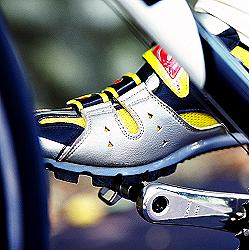 |
 |
 |
Balance,
control, and comfort are key points to maintaining a positive experience
while riding your Dahon bicycle. Small adjustments in riding position
can have an amazing positive effect in ride quality during your bicycle
outings and commutes. Be sure to consider the following when setting
up and riding your bike.
Take the time to adjust your bike to fit properly. Saddle adjustments,
which includes: tilt, fore-and-aft, and height are essential components
of proper bike fit. Please see more detailed information on Saddle
Adjustment in the following section.
Your arms and shoulders should not be too rigid. They should have
some flexibility to adapt to uneven road conditions, and aid in agile
response and recovery. Be sure to keep your elbows slightly bent and
relaxed, while maintaining a sturdy grip on the handlebars. Your arms
are natural shock absorbers, and will allow you to balance better
while riding.
Don't worry too much about riding in an aerodynamic position. Aerodynamics
doesn't really provide much of a benefit at under a traveling speed
of 15mph. An aerodynamic position (more horizontally prone torso)
creates excessive tension in the neck and shoulder area, and also
makes visibility difficulty.
The following pictures are of me, Rick (6'2", 188 cm), and Sunny
(5'5", 165 cm) on the same 20" wheeled Dahon folding bicycle.
You can see that with adjusting the Saddle Fore-and-Aft, and the Saddle
Height, the bicycle is able to accommodate different sized riders.
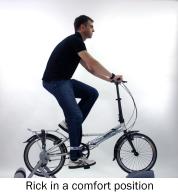 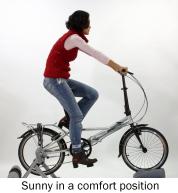
SADDLE ADJUSTMENT
Saddle Tilt
Adjust the saddle as level as possible so that your sit bones (ischial
tuberosities) are stationary and don't feel as if they are rolling
forward or back on the saddle. New riders often times will position
their saddle nose down with the thought of easing pain in the groin
area. This position actually makes it difficult to stay on the saddle.
It tends to make your hips roll forward and slide down the saddle.
This puts more pressure on your arms and hands and reduces the possibility
to be relaxed, well balanced, and in control of the bike.
Saddle Fore and Aft
This adjustment determines how well you are balanced on the bike between
the seat and handlebars. The forward most position would place the
majority of your weight on the saddle. The rearward most position
(aft) would increase the amount of weight supported on your arms,
hands and handlebars. You may have to make several adjustments during
your first riding experiences to get this right. You are looking for
balance. A common road bike ratio is 45% fore (on front wheel) and
55% aft (on rear wheel) of your body weight. A good starting position
is called "KOPS"; Knee Over Pedal Spindle. With this technique
you would drop a "plumb bob" from the bump just below your
knee joint, with the pedal in the forward-most horizontal position
of the stroke. The plumb bob should point at the center of the pedal
spindle. From here you can move the saddle forward or aft to tune-in
your best riding position. You can simply use a string and a large
fender washer as the"plumb bob".
Saddle Height
When the seat height is adjusted properly there should be a slight
bend at your knee when in the bottom of the stroke as you pedal. If
the saddle is adjusted too low you lose pedaling efficiency and put
undue stress on the knee joint when at the top of the pedal stroke.
If the saddle is adjusted too high, your knees will hyper-extend and
your pelvis will rock side to side on the saddle. This too is not
healthy for your knees and will also create more friction in the saddle
area.
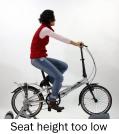  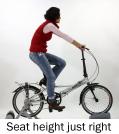
Adjustable handlepost
On Dahon bicycles with the adjustable handlepost, you have the capability
for even more adjustment for better fit, and different riding positions.
In the pictures below see how lowering the handlepost achieves a more
"sporty" position.
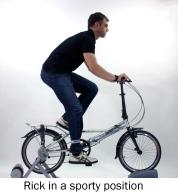 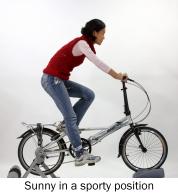 |
|
 |
 |
|


